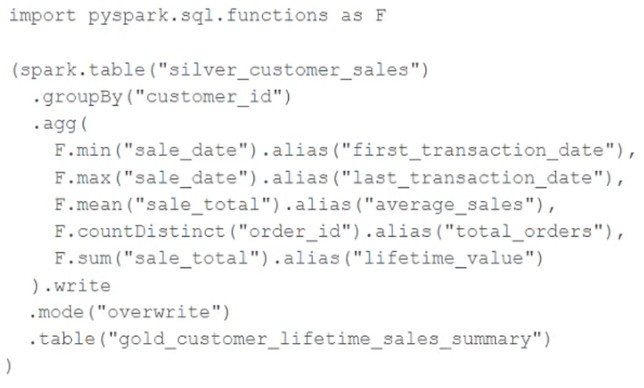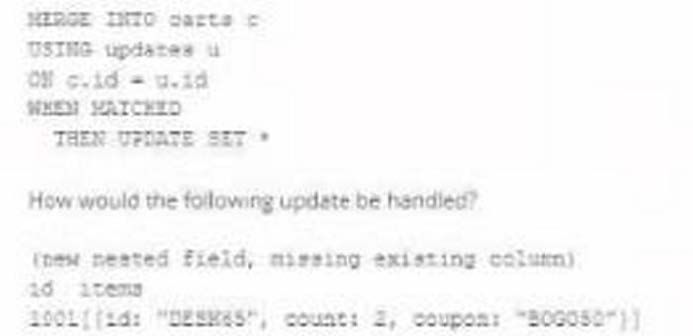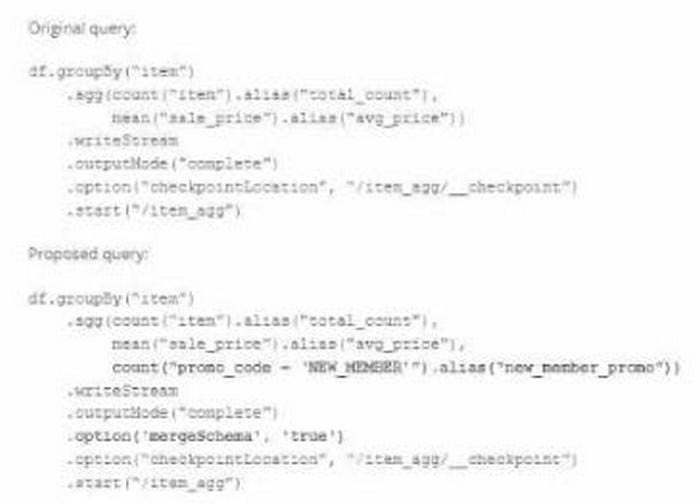Exam Details
Exam Code
:DATABRICKS-CERTIFIED-PROFESSIONAL-DATA-ENGINEERExam Name
:Databricks Certified Data Engineer ProfessionalCertification
:Databricks CertificationsVendor
:DatabricksTotal Questions
:120 Q&AsLast Updated
:Jul 02, 2025
Databricks Databricks Certifications DATABRICKS-CERTIFIED-PROFESSIONAL-DATA-ENGINEER Questions & Answers
-
Question 1:
A data engineer wants to join a stream of advertisement impressions (when an ad was shown) with another stream of user clicks on advertisements to correlate when impression led to monitizable clicks.

Which solution would improve the performance?

A. Option A
B. Option B
C. Option C
D. Option D
-
Question 2:
A junior developer complains that the code in their notebook isn't producing the correct results in the development environment. A shared screenshot reveals that while they're using a notebook versioned with Databricks Repos, they're using a personal branch that contains old logic. The desired branch named dev-2.3.9 is not available from the branch selection dropdown.
Which approach will allow this developer to review the current logic for this notebook?
A. Use Repos to make a pull request use the Databricks REST API to update the current branch to dev-2.3.9
B. Use Repos to pull changes from the remote Git repository and select the dev-2.3.9 branch.
C. Use Repos to checkout the dev-2.3.9 branch and auto-resolve conflicts with the current branch
D. Merge all changes back to the main branch in the remote Git repository and clone the repo again
E. Use Repos to merge the current branch and the dev-2.3.9 branch, then make a pull request to sync with the remote repository
-
Question 3:
The data engineering team maintains the following code: Assuming that this code produces logically correct results and the data in the source table has been de-duplicated and validated, which statement describes what will occur when this code is executed?

A. The silver_customer_sales table will be overwritten by aggregated values calculated from all records in the gold_customer_lifetime_sales_summary table as a batch job.
B. A batch job will update the gold_customer_lifetime_sales_summary table, replacing only those rows that have different values than the current version of the table, using customer_id as the primary key.
C. The gold_customer_lifetime_sales_summary table will be overwritten by aggregated values calculated from all records in the silver_customer_sales table as a batch job.
D. An incremental job will leverage running information in the state store to update aggregate values in the gold_customer_lifetime_sales_summary table.
E. An incremental job will detect if new rows have been written to the silver_customer_sales table; if new rows are detected, all aggregates will be recalculated and used to overwrite the gold_customer_lifetime_sales_summary table.
-
Question 4:
A Data engineer wants to run unit's tests using common Python testing frameworks on python functions defined across several Databricks notebooks currently used in production.
How can the data engineer run unit tests against function that work with data in production?
A. Run unit tests against non-production data that closely mirrors production
B. Define and unit test functions using Files in Repos
C. Define units test and functions within the same notebook
D. Define and import unit test functions from a separate Databricks notebook
-
Question 5:
The following table consists of items found in user carts within an e-commerce website.

The following MERGE statement is used to update this table using an updates view, with schema evaluation enabled on this table.

How would the following update be handled?
A. The update is moved to separate ''restored'' column because it is missing a column expected in the target schema.
B. The new restored field is added to the target schema, and dynamically read as NULL for existing unmatched records.
C. The update throws an error because changes to existing columns in the target schema are not supported.
D. The new nested field is added to the target schema, and files underlying existing records are updated to include NULL values for the new field.
-
Question 6:
A data team's Structured Streaming job is configured to calculate running aggregates for item sales to update a downstream marketing dashboard. The marketing team has introduced a new field to track the number of times this promotion code is used for each item. A junior data engineer suggests updating the existing query as follows: Note that proposed changes are in bold.

Which step must also be completed to put the proposed query into production?
A. Increase the shuffle partitions to account for additional aggregates
B. Specify a new checkpointlocation
C. Run REFRESH TABLE delta, /item_agg'
D. Remove .option (mergeSchema', true') from the streaming write
-
Question 7:
The Databricks workspace administrator has configured interactive clusters for each of the data engineering groups. To control costs, clusters are set to terminate after 30 minutes of inactivity. Each user should be able to execute workloads against their assigned clusters at any time of the day.
Assuming users have been added to a workspace but not granted any permissions, which of the following describes the minimal permissions a user would need to start and attach to an already configured cluster.
A. "Can Manage" privileges on the required cluster
B. Workspace Admin privileges, cluster creation allowed. "Can Attach To" privileges on the required cluster
C. Cluster creation allowed. "Can Attach To" privileges on the required cluster
D. "Can Restart" privileges on the required cluster
E. Cluster creation allowed. "Can Restart" privileges on the required cluster
-
Question 8:
The data engineering team maintains a table of aggregate statistics through batch nightly updates. This includes total sales for the previous day alongside totals and averages for a variety of time periods including the 7 previous days, year-todate, and quarter-to-date. This table is named store_saies_summary and the schema is as follows:

The table daily_store_sales contains all the information needed to update store_sales_summary. The schema for this table is:
store_id INT, sales_date DATE, total_sales FLOAT
If daily_store_sales is implemented as a Type 1 table and the total_sales column might be adjusted after manual data auditing, which approach is the safest to generate accurate reports in the store_sales_summary table?
A. Implement the appropriate aggregate logic as a batch read against the daily_store_sales table and overwrite the store_sales_summary table with each Update.
B. Implement the appropriate aggregate logic as a batch read against the daily_store_sales table and append new rows nightly to the store_sales_summary table.
C. Implement the appropriate aggregate logic as a batch read against the daily_store_sales table and use upsert logic to update results in the store_sales_summary table.
D. Implement the appropriate aggregate logic as a Structured Streaming read against the daily_store_sales table and use upsert logic to update results in the store_sales_summary table.
E. Use Structured Streaming to subscribe to the change data feed for daily_store_sales and apply changes to the aggregates in the store_sales_summary table with each update.
-
Question 9:
A production workload incrementally applies updates from an external Change Data Capture feed to a Delta Lake table as an always-on Structured Stream job. When data was initially migrated for this table, OPTIMIZE was executed and most data files were resized to 1 GB. Auto Optimize and Auto Compaction were both turned on for the streaming production job. Recent review of data files shows that most data files are under 64 MB, although each partition in the table contains at least 1 GB of data and the total table size is over 10 TB.
Which of the following likely explains these smaller file sizes?
A. Databricks has autotuned to a smaller target file size to reduce duration of MERGE operations
B. Z-order indices calculated on the table are preventing file compaction C Bloom filler indices calculated on the table are preventing file compaction
C. Databricks has autotuned to a smaller target file size based on the overall size of data in the table
D. Databricks has autotuned to a smaller target file size based on the amount of data in each partition
-
Question 10:
Which statement regarding stream-static joins and static Delta tables is correct?
A. Each microbatch of a stream-static join will use the most recent version of the static Delta table as of each microbatch.
B. Each microbatch of a stream-static join will use the most recent version of the static Delta table as of the job's initialization.
C. The checkpoint directory will be used to track state information for the unique keys present in the join.
D. Stream-static joins cannot use static Delta tables because of consistency issues.
E. The checkpoint directory will be used to track updates to the static Delta table.
Related Exams:
DATABRICKS-CERTIFIED-ASSOCIATE-DEVELOPER-FOR-APACHE-SPARK
Databricks Certified Associate Developer for Apache Spark 3.0DATABRICKS-CERTIFIED-DATA-ANALYST-ASSOCIATE
Databricks Certified Data Analyst AssociateDATABRICKS-CERTIFIED-DATA-ENGINEER-ASSOCIATE
Databricks Certified Data Engineer AssociateDATABRICKS-CERTIFIED-GENERATIVE-AI-ENGINEER-ASSOCIATE
Databricks Certified Generative AI Engineer AssociateDATABRICKS-CERTIFIED-PROFESSIONAL-DATA-ENGINEER
Databricks Certified Data Engineer ProfessionalDATABRICKS-CERTIFIED-PROFESSIONAL-DATA-SCIENTIST
Databricks Certified Professional Data ScientistDATABRICKS-MACHINE-LEARNING-ASSOCIATE
Databricks Certified Machine Learning AssociateDATABRICKS-MACHINE-LEARNING-PROFESSIONAL
Databricks Certified Machine Learning Professional
Tips on How to Prepare for the Exams
Nowadays, the certification exams become more and more important and required by more and more enterprises when applying for a job. But how to prepare for the exam effectively? How to prepare for the exam in a short time with less efforts? How to get a ideal result and how to find the most reliable resources? Here on Vcedump.com, you will find all the answers. Vcedump.com provide not only Databricks exam questions, answers and explanations but also complete assistance on your exam preparation and certification application. If you are confused on your DATABRICKS-CERTIFIED-PROFESSIONAL-DATA-ENGINEER exam preparations and Databricks certification application, do not hesitate to visit our Vcedump.com to find your solutions here.